engine coolant FORD MUSTANG 2001 4.G SVT Supplement Manual
[x] Cancel search | Manufacturer: FORD, Model Year: 2001, Model line: MUSTANG, Model: FORD MUSTANG 2001 4.GPages: 20, PDF Size: 0.19 MB
Page 6 of 20
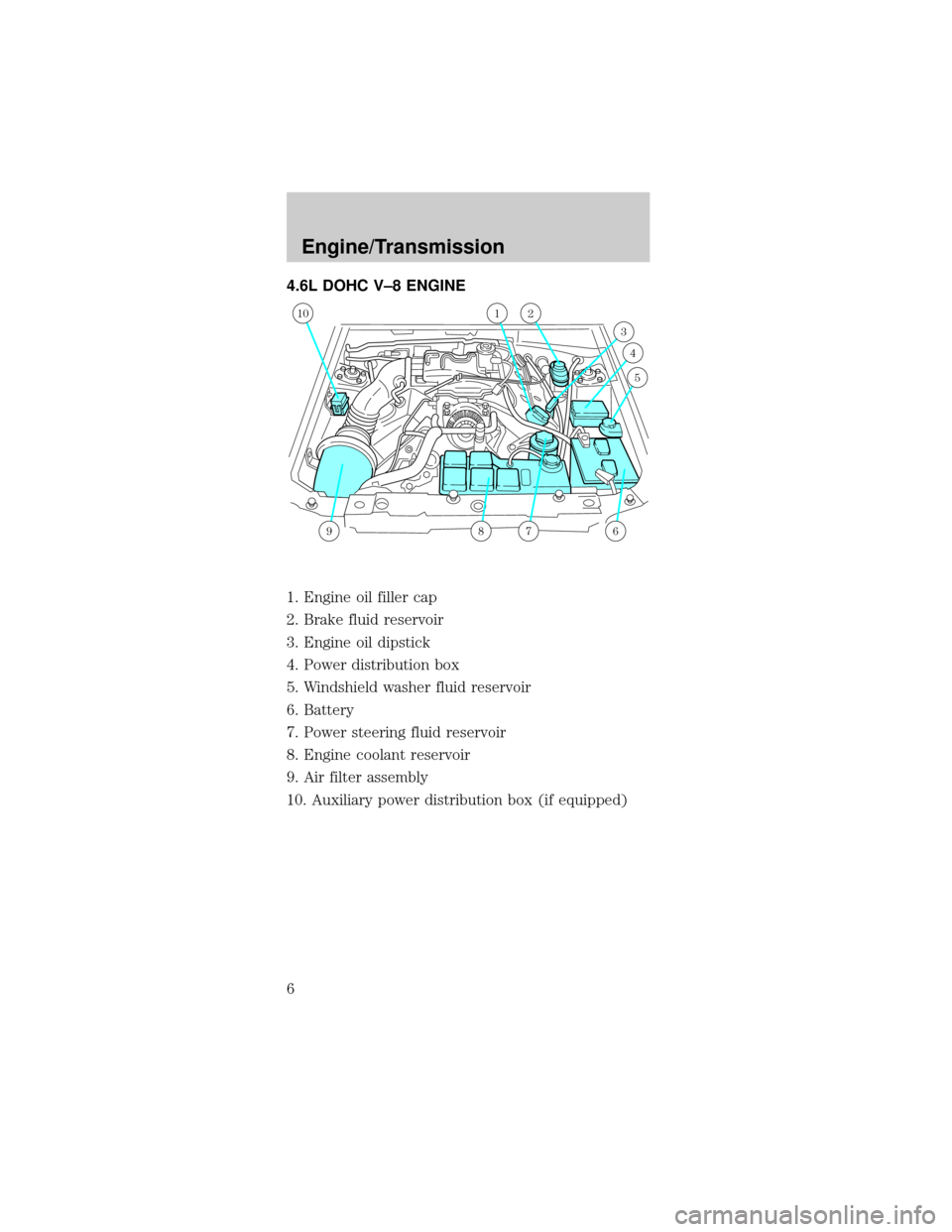
4.6L DOHC V±8 ENGINE
1. Engine oil filler cap
2. Brake fluid reservoir
3. Engine oil dipstick
4. Power distribution box
5. Windshield washer fluid reservoir
6. Battery
7. Power steering fluid reservoir
8. Engine coolant reservoir
9. Air filter assembly
10. Auxiliary power distribution box (if equipped)
9867
1102
3
4
5
Engine/Transmission
6
Page 14 of 20
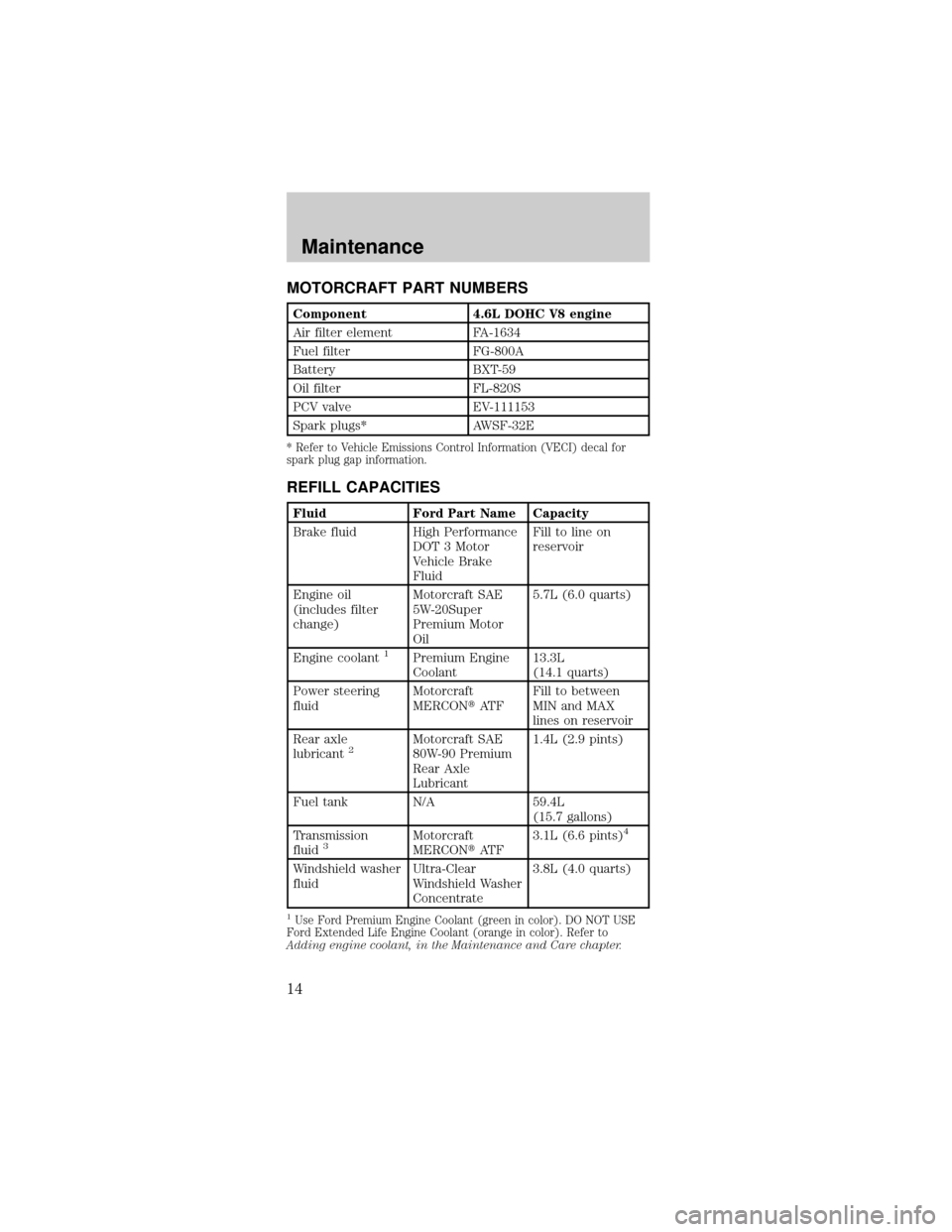
MOTORCRAFT PART NUMBERS
Component 4.6L DOHC V8 engine
Air filter element FA-1634
Fuel filter FG-800A
Battery BXT-59
Oil filter FL-820S
PCV valve EV-111153
Spark plugs* AWSF-32E
* Refer to Vehicle Emissions Control Information (VECI) decal for
spark plug gap information.
REFILL CAPACITIES
Fluid Ford Part Name Capacity
Brake fluid High Performance
DOT 3 Motor
Vehicle Brake
FluidFill to line on
reservoir
Engine oil
(includes filter
change)Motorcraft SAE
5W-20Super
Premium Motor
Oil5.7L (6.0 quarts)
Engine coolant
1Premium Engine
Coolant13.3L
(14.1 quarts)
Power steering
fluidMotorcraft
MERCONtAT FFill to between
MIN and MAX
lines on reservoir
Rear axle
lubricant
2Motorcraft SAE
80W-90 Premium
Rear Axle
Lubricant1.4L (2.9 pints)
Fuel tank N/A 59.4L
(15.7 gallons)
Transmission
fluid
3Motorcraft
MERCONtAT F3.1L (6.6 pints)4
Windshield washer
fluidUltra-Clear
Windshield Washer
Concentrate3.8L (4.0 quarts)
1Use Ford Premium Engine Coolant (green in color). DO NOT USE
Ford Extended Life Engine Coolant (orange in color). Refer to
Adding engine coolant, in the Maintenance and Care chapter.
Maintenance
14
Page 16 of 20
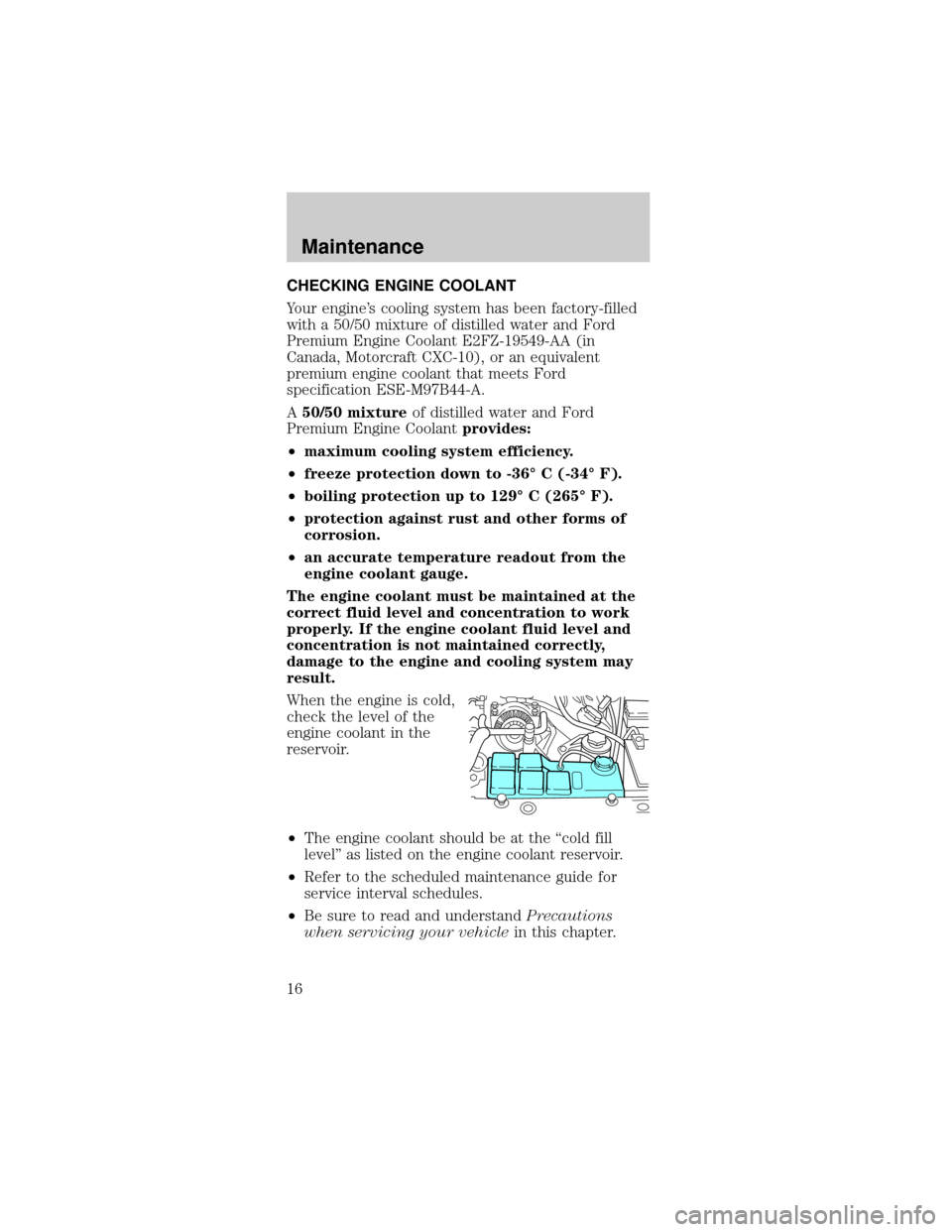
CHECKING ENGINE COOLANT
Your engine's cooling system has been factory-filled
with a 50/50 mixture of distilled water and Ford
Premium Engine Coolant E2FZ-19549-AA (in
Canada, Motorcraft CXC-10), or an equivalent
premium engine coolant that meets Ford
specification ESE-M97B44-A.
A50/50 mixtureof distilled water and Ford
Premium Engine Coolantprovides:
²maximum cooling system efficiency.
²freeze protection down to -36É C (-34É F).
²boiling protection up to 129É C (265É F).
²protection against rust and other forms of
corrosion.
²an accurate temperature readout from the
engine coolant gauge.
The engine coolant must be maintained at the
correct fluid level and concentration to work
properly. If the engine coolant fluid level and
concentration is not maintained correctly,
damage to the engine and cooling system may
result.
When the engine is cold,
check the level of the
engine coolant in the
reservoir.
²The engine coolant should be at the ªcold fill
levelº as listed on the engine coolant reservoir.
²Refer to the scheduled maintenance guide for
service interval schedules.
²Be sure to read and understandPrecautions
when servicing your vehiclein this chapter.
Maintenance
16
Page 17 of 20
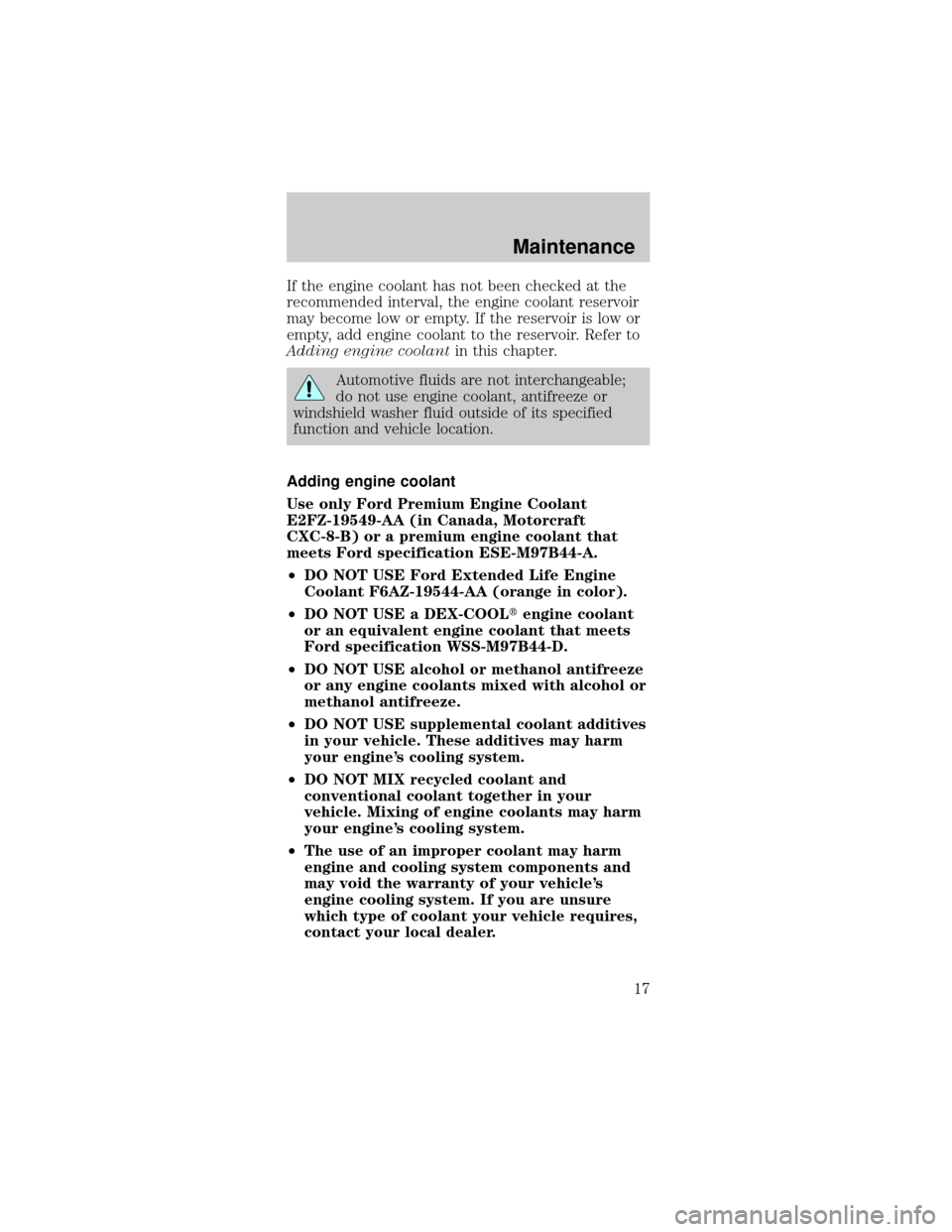
If the engine coolant has not been checked at the
recommended interval, the engine coolant reservoir
may become low or empty. If the reservoir is low or
empty, add engine coolant to the reservoir. Refer to
Adding engine coolantin this chapter.
Automotive fluids are not interchangeable;
do not use engine coolant, antifreeze or
windshield washer fluid outside of its specified
function and vehicle location.
Adding engine coolant
Use only Ford Premium Engine Coolant
E2FZ-19549-AA (in Canada, Motorcraft
CXC-8-B) or a premium engine coolant that
meets Ford specification ESE-M97B44-A.
²DO NOT USE Ford Extended Life Engine
Coolant F6AZ-19544-AA (orange in color).
²DO NOT USE a DEX-COOLtengine coolant
or an equivalent engine coolant that meets
Ford specification WSS-M97B44-D.
²DO NOT USE alcohol or methanol antifreeze
or any engine coolants mixed with alcohol or
methanol antifreeze.
²DO NOT USE supplemental coolant additives
in your vehicle. These additives may harm
your engine's cooling system.
²DO NOT MIX recycled coolant and
conventional coolant together in your
vehicle. Mixing of engine coolants may harm
your engine's cooling system.
²The use of an improper coolant may harm
engine and cooling system components and
may void the warranty of your vehicle's
engine cooling system. If you are unsure
which type of coolant your vehicle requires,
contact your local dealer.
Maintenance
17
Page 18 of 20
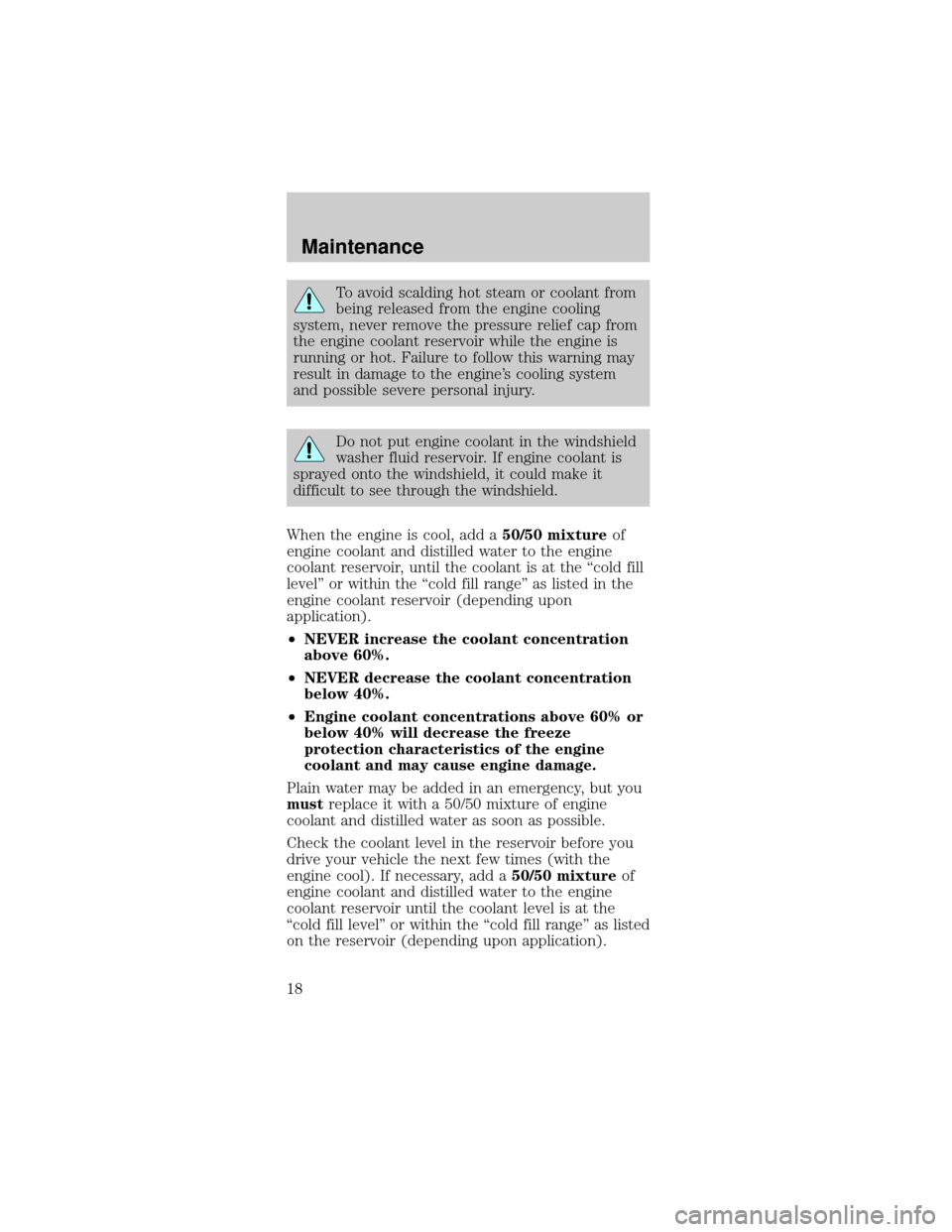
To avoid scalding hot steam or coolant from
being released from the engine cooling
system, never remove the pressure relief cap from
the engine coolant reservoir while the engine is
running or hot. Failure to follow this warning may
result in damage to the engine's cooling system
and possible severe personal injury.
Do not put engine coolant in the windshield
washer fluid reservoir. If engine coolant is
sprayed onto the windshield, it could make it
difficult to see through the windshield.
When the engine is cool, add a50/50 mixtureof
engine coolant and distilled water to the engine
coolant reservoir, until the coolant is at the ªcold fill
levelº or within the ªcold fill rangeº as listed in the
engine coolant reservoir (depending upon
application).
²NEVER increase the coolant concentration
above 60%.
²NEVER decrease the coolant concentration
below 40%.
²Engine coolant concentrations above 60% or
below 40% will decrease the freeze
protection characteristics of the engine
coolant and may cause engine damage.
Plain water may be added in an emergency, but you
mustreplace it with a 50/50 mixture of engine
coolant and distilled water as soon as possible.
Check the coolant level in the reservoir before you
drive your vehicle the next few times (with the
engine cool). If necessary, add a50/50 mixtureof
engine coolant and distilled water to the engine
coolant reservoir until the coolant level is at the
ªcold fill levelº or within the ªcold fill rangeº as listed
on the reservoir (depending upon application).
Maintenance
18
Page 19 of 20
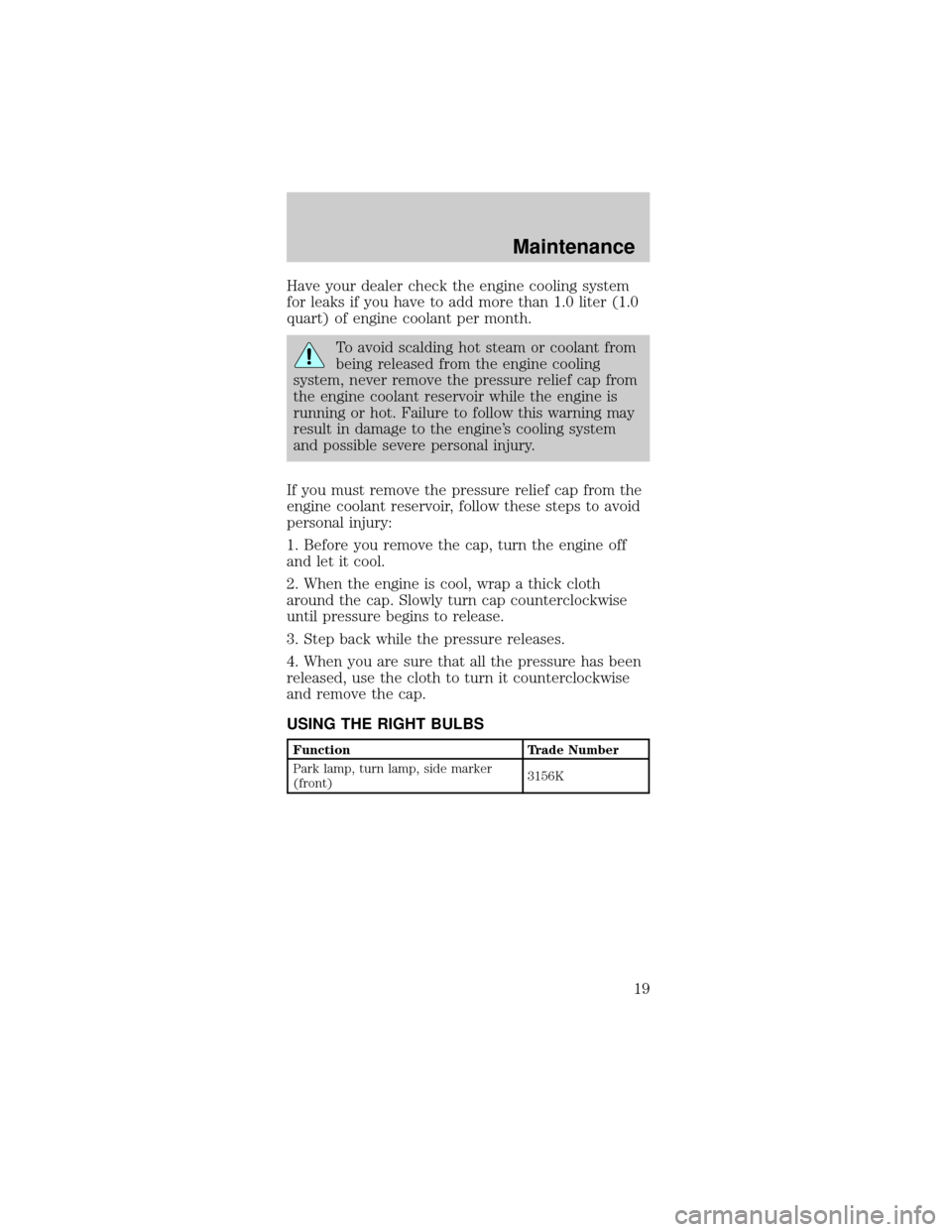
Have your dealer check the engine cooling system
for leaks if you have to add more than 1.0 liter (1.0
quart) of engine coolant per month.
To avoid scalding hot steam or coolant from
being released from the engine cooling
system, never remove the pressure relief cap from
the engine coolant reservoir while the engine is
running or hot. Failure to follow this warning may
result in damage to the engine's cooling system
and possible severe personal injury.
If you must remove the pressure relief cap from the
engine coolant reservoir, follow these steps to avoid
personal injury:
1. Before you remove the cap, turn the engine off
and let it cool.
2. When the engine is cool, wrap a thick cloth
around the cap. Slowly turn cap counterclockwise
until pressure begins to release.
3. Step back while the pressure releases.
4. When you are sure that all the pressure has been
released, use the cloth to turn it counterclockwise
and remove the cap.
USING THE RIGHT BULBS
Function Trade Number
Park lamp, turn lamp, side marker
(front)3156K
Maintenance
19